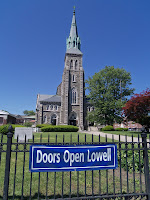 |
| Grotto at Notre Dame Academy, Lowell |
Again the Journal of the Sisters of Notre Dame provides an
insight into parish life over a century ago.
For decades, hundreds of hundreds of families, students, neighborhood
families and religious made the pilgrimage to the grotto. The May Procession had been a tradition for
many years before the erection of the grotto.
It was customary for the school children, at first just the girls of the
school and later boys and girls once the Sisters’ rule allowed them to teach
both sexes, to process through the Sisters’ cloister garden and crown a statue
of Mary. An eighth grade girl was always
chosen to crown the statue, it was a major coup to be given the privilege to
put on the satin gown and carry the pillow with the flowered crown. She was preceded by the entire student body
along with any new First Communicants that had received that month, the girls
in their white dresses and veils, the boys in white suits and ties. Up until the 1950s, the garden was out of
bounds for men except on special occasions, such as the annual Garden Party,
Corpus Christi procession, or May Crowning.
In the back of the school today the outline of the grotto
can still be discerned. It remained
standing until the 1960s when I witnessed its razing. The nuns constantly warned us not to climb on
the grotto at recess. You can predict
what happened next. A fellow student in
my class (who will remain nameless, though the nuns I’m sure inscribed his name
in some book of the damned) ignored the Sister’s warnings. Predictably he fell off, and a few stones
fell with him. The structure was deemed
unsafe, and the workmen came and tore it down while we looked out the
window. Our nun looked on sadly and
reminded us that Mary no longer had a grotto because of our disobedience. Ahhh,
good old Catholic guilt! The
statue disappeared for about 40 years, and then was returned to the Sisters at
the school. She’s had some cosmetic work
done and doesn’t look too bad for her age.
She’s back at St. Pat’s where she was meant to be.
Thanks to Walt’s family we can share a look into those Acre
days-
In the second, we are shown leaving the church. Visible in the background are the old heavy
wooden doors.
These photos show the procession for the “Joyful Mysteries” in which we as second graders went en masse to church during school. The Sister is Sister Mary Owen, who was our second grade teacher. In the background of the photo of us leaving the church are the schools and the Sisters' Chapel. I cannot make out the Mystery written on the pillow of the young lady leading our class, but our group was followed by the Visitation.
These photos show the procession for the “Joyful Mysteries” in which we as second graders went en masse to church during school. The Sister is Sister Mary Owen, who was our second grade teacher. In the background of the photo of us leaving the church are the schools and the Sisters' Chapel. I cannot make out the Mystery written on the pillow of the young lady leading our class, but our group was followed by the Visitation.











